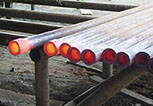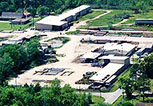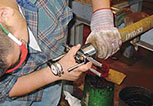Manufacturing
Maxi-rig operators have long used forged-end inertia-welded rods for their most demanding projects. Additionally, the rugged design of forged-end inertia-welded drill pipe tool joints have been the standard for oilfield drill pipe for many years. As evidence of Premier product integrity, performance and reliability, we manufacture and distribute virtually all sizes of Vermeer®, Jet Trac® and Case® compatible rods, as well as rods for most other rigs.
Unlike most HDD rod manufacturers, including several major rig OEM’s, Premier is not dependent on outside vendors or services for the production of our tubular products, we do it all in-house. This not only allows Premier to produce and deliver the most cost-effective drill rod in the industry, it also allows complete control of quality over each phase of the manufacturing process. We utilize a high strength, low alloy steel specifically formulated to maximize fatigue resistance and rod longevity. We only buy raw pipe manufactured to the exacting specifications of the American Petroleum Institute (API). The entire manufacturing process from forging and inertia welding to quenching and tempering, machining and inspection are performed at Premier facilities to make sure that the quality and reliability of our products meet our high product standards.
Maximizing Rod Life Through Preventive Maintenance
- After loading rod racks with new rod, store thread protectors in a clean safe place and always re-install them if the rods are removed from the rack for any reason.
- Replace old, worn drive chucks when replacing the rod string. Additionally, since most HDD rods feature a double-shouldered design, even the slightest face-wear on the drive chuck will prevent the pin shoulder from fully seating in the chuck. If this happens, pin failures are swift and inevitable.
- Always avoid combining used with new rods in the string. Isolating new rods at one end of the string does nothing. All rods still contact the drive chuck twice on every bore. If the old drive chuck is left on, it will quickly damage the new rods. If you replace the drive chuck it will then be damaged by the worn thread profiles of the used rod, and quickly transfer this damage to the new rods. Depending on the profiles of your old rods this can happen in as little as a few weeks.
- Make up your rod at the surface to 60% of its yield torque. If you are not sure of the yield torque specifications contact your rod manufacturer. Rods not properly torqued at the surface will attempt to make up while boring and box swelling will occur.
- Keep the threads properly coated with a high quality copper-based thread compound.
- Perform a wet magnetic particle inspection on your rods at intervals no longer than every six months, more frequently if the rod has been subjected to demanding boring operations.
- Routinely rotate your string from front to back. This will insure that each rod gets equal wear. This procedure also equalizes the drilling torque that each rod sees over the life of the string.
- Please keep rod ends out of the dirt! This should go without saying but happens all too often with careless operators. Gravel and sand picked up in the thread compound is detrimental to the threads and adversely affects torque when rods are made up


